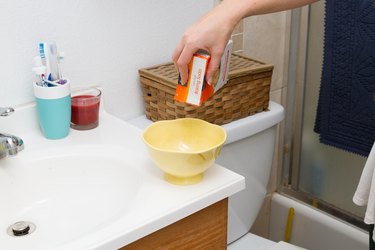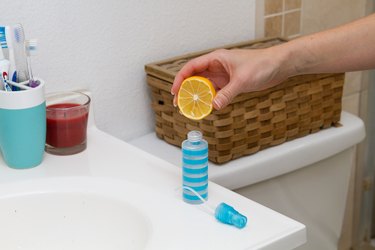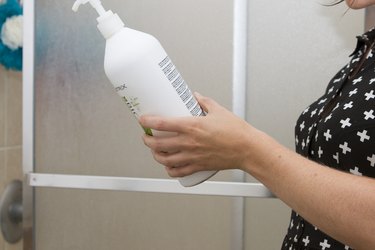
The abundance of iron in the earth's core means that the mineral can sometimes seep into the water in which you bathe and wash your hair. The Illinois Department of Public Health states that very small amounts of iron as low as 0.3 mg per liter of water can cause a discoloration of the water, which can translate to buildup and possibly staining of your hair. Get iron buildup out of your hair by making a few changes to your hair care routine.
Step 1

Squirt a handful of your regular shampoo into your hand or a small cup. Add a teaspoon of baking soda and stir. Adjust the amount of baking soda until the shampoo reaches a paste-like consistency. Work the shampoo into your hair, leave on for a few minutes and rinse.
Video of the Day
Baking soda, a natural cleanser most people tend to keep in their homes, removes a variety of chemicals and trace minerals from your hair. Depending on the extent of damage from iron, you may need to shampoo with baking soda for up to three months.
Step 2

Treat your hair with citric acids to get iron and other metals and minerals out of your hair. Lemon juice and tomato juice are both effective treatments for removing green discoloration associated with copper buildup and exposure to chlorine. This method may also work to get the orange-brown rust stains from iron out of your hair.
Fill a spray bottle with either lemon or tomato juice. Spray on your head until your hair is saturated. After about five minutes, rinse your hair and wash with shampoo.
Step 3

Use a commercial clarifying or purifying shampoo periodically to remove buildup from not only iron, copper and other minerals, but from hair products as well. Shampoos of this kind can be especially drying, so intersperse this hair care routine with your normal shampooing and conditioning. Try using the purifying shampoo once weekly to remove iron buildup and staining.
Things You'll Need
Baking soda
Shampoo
Cup
Spoon
Lemon or tomato juice
Spray bottle
Clarifying shampoo
Video of the Day
Is this an emergency? If you are experiencing serious medical symptoms, please see the National Library of Medicine’s list of signs you need emergency medical attention or call 911.